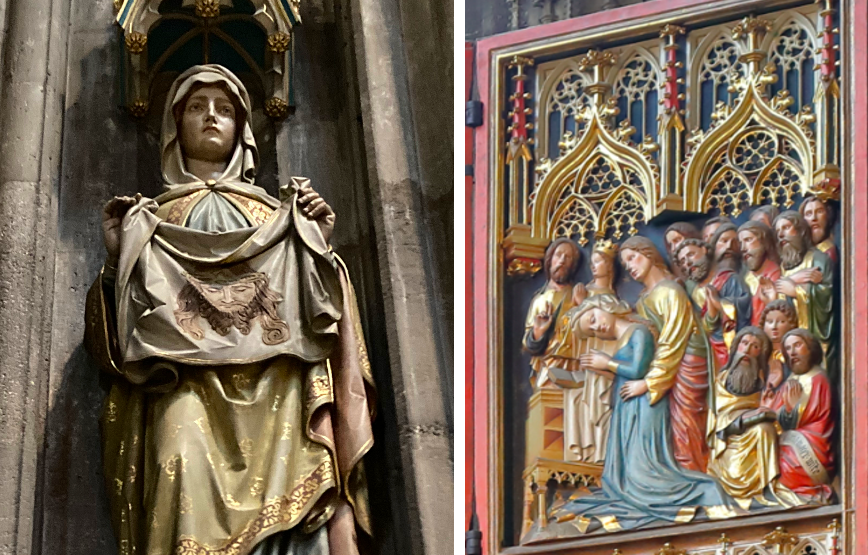My Regensburg Year, Part 2: September 2024
Our second month in Regensburg included a visit from home, an encounter with a “climate event,” and a meeting with the boss.
When we told our family and friends about our year-long stay in Regensburg, we invited everyone to come and visit if they were able. Few people, alas, have taken us up on this invitation. Is it because Germany is just not that attractive a tourist vacation? Is it the expense? Is it (gulp) US? We had our first intrepid visitor early this month when my mother came to town. Mum visits her sisters in England every year, so it was a quick and easy jump across the channel to see us. And because it was her first trip to continental Europe, we were determined to “show her a good time.” But we may have overdone it. My mum is quite fit even at 79 but she had to endure a lot of walking at the tail end of a heatwave. Still, she survived and together we explored the city (including our first visit to the Historische Museum for its Roman artifacts), and journeyed outside to nearby Passau, Munich, and Salzburg.

Our other major sightseeing excursion was a trip to Vienna that coincided with a major rain storm that resulted in floods throughout the region. Good timing! We’d like to say we “saw” Vienna but what we saw was mostly sidewalk as we pushed through the wind and rain with our heads down, moving from one museum or art gallery to another. We did get to see an excellent performance of Vivaldi’s Four Seasons at St. Stephen’s Cathedral (which, to my disappointment, had no apocryphal iconography of Stephen; see below) and visited the papyrus museum at the Österreichische Nationalbibliothek. Due to the flooding, we had to stay an extra night in town and our route home was expected to be inaccessible for days. Luckily we were able to take a long journey home through Prague. We will take another crack at Vienna in December. Rounding out our free time this month was a day trip to Nuremberg to see the Nazi Party Rally Grounds and an afternoon watching Regensburg’s first ever Dachshund Parade (as weird and wonderful as it sounds).
 At the Beyond Canon offices, we were finally treated to an appearance by the “boss” (Tobias Nicklas). August and September are still vacation time here, and classes don’t actually start until October. So we are now seeing more of Tobias and more and more students on campus. Tobias and I grabbed lunch and discussed collaboration on an interesting, but challenging, project (more to come).
At the Beyond Canon offices, we were finally treated to an appearance by the “boss” (Tobias Nicklas). August and September are still vacation time here, and classes don’t actually start until October. So we are now seeing more of Tobias and more and more students on campus. Tobias and I grabbed lunch and discussed collaboration on an interesting, but challenging, project (more to come).
But what about work? I am currently scrambling to finish the final chapter of the second half of my Anchor Bible magnum opus covering apocryphal acts (no, that does not mean I have finished the first half). The first three chapters of the section cover the early acts (Peter, Paul, Thomas, John, and Andrew), then comes one on the other members of the Twelve, and finally comes “the rest” (disciples, evangelists, and family members). Some of this material has been very challenging to work with because it has either never been published or never been translated into a modern language. So while it can be rewarding to read little-seen texts, it is so much work to write about them! One of the more challenging figures to cover is the proto-martyr Stephen.
The Clavis Apocryphorum Novum Testamentum (CANT) lists several texts on Stephen: Acts of Stephen (Coptic) (ECCA 255; CANT 300), Acts of Stephen (Arabic) (ECCA 965; CANT 301), Homily on Stephen by Theodosius of Jerusalem (ECCA 494; CANT 302), and Martyrdom of Stephen (ECCA 735; CANT 303). To these I have added to e-Clavis entries on Life and Martyrdom of Stephen (ECCA 734), and Revelation of Stephen (ECCA 864), though this final text focuses on the discovery of the saint’s relics, so I may end up removing it from the database.
Little attention has been paid to the Stephen corpus; none of the texts even appear in the apocrypha compendia. But there have been several studies, most of them quite recent, that help sort out the material: François Bovon’s “Dossier on Stephen” (2003) which describes each of the texts and their sources, Damien Labadie’s L’invention du protomartyr Étienne (2021) which includes an updates to Bovon’s list and looks at the development of the devotion to Stephen, Hugo Méndez’s Cult of Stephen in Jerusalem (2022) which covers similar ground, and Rose Sawyer’s Medieval Changeling (2023) which focuses on the Latin Life and Martyrdom of Stephen neglected by CANT.
The earliest text on Stephen is the Martyrdom (CANT 303), preserved in Georgian but translated from Greek. This earlier Greek text was also expanded into two longer Greek forms (Greek D and H) and other adaptations. Generally the versions of the text became more orthodox over time with material from Stephen’s canonical martyrdom account replacing the noncanonical. Notable among these apocryphal features are an increased role for Paul in Stephen’s death (he appears at Stephen’s interrogation, at one point inciting the centurion Claudius to cut off his head), the addition of Pilate to the story (defending Stephen and wishing to provide him a proper burial), the introduction of Stephen’s father Zacchaeus, and in one branch of the tradition, the martyrdoms of Nicodemus, Gamaliel, and his son Abib alongside Stephen.
The Arabic and Coptic Acts of Stephen tell entirely different stories. The Arabic presents a miracle challenge between Stephen and two magicians, Yuas and Aristodemus, culminating in their conversion to the Christian faith. The text then segues into the story of the ordination of the seven deacons (Acts 6:1–6) and Stephen’s martyrdom (Acts 6:8—8:1), and concludes with his burial beside the temple. The Coptic Acts focuses entirely on Stephen’s life before the martyrdom. We learn he was married and had a daughter, who died a virgin (to Stephen’s delight), and that three of the seven deacons were once rogues who tried to kill Stephen. Another Coptic tradition, the Homily attributed to Theodosius, is entirely unpublished so it is not known how much of the text includes material that could be considered “apocryphal.”
To me, the most interesting text of the Stephen corpus is the Life and Martyrdom of Stephen. This text draws upon the motif of the changeling, defined by Rose Sawyer as “a creature, generally supernatural in nature, who is substituted for a human, almost invariably during the said human’s infancy” (2023:2); essentially, the concept explains how a much-desired child turned out to be sickly and colicky and how to remedy the problem through ritual acts. The changeling motif appears in stories of three saints: Stephen, Bartholomew (in Nativity of Bartholomew, ECCA 359), and Lawrence, with the accounts of Stephen being the earliest. The changeling stories of Stephen are numerous, with only three versions published to date. But they all tell the basic story of Stephen’s aged and pious parents being granted a son, only to have the child replaced by Satan with a demon. Stephen is raised by a bishop named Julian (oddly, a Christian bishop before Christianity) and when he grows to adulthood he journeys home and dispels the demon. Then Stephen goes to Jerusalem where he preaches and meets his demise.
 Despite their relative neglect in scholarship, these changeling traditions of Stephen were dispersed quite widely, particularly in iconography. A number of churches are decorated with frescoes illustrating episodes from the text; seven are listed in the e-Clavis entry, with five of them documented in separate Materiae apocryphorum pages (with acknowledgment to the surveys of these sites in Sawyer 2023 and Kaftal 1973). The most elaborate (and well-preserved) of the cycles is the thirteen panels of the Oratorio di Santo Stefano in Lentate sul Seveso (14th cent.). And as I mentioned above, alas no such cycle appears in Vienna.
Despite their relative neglect in scholarship, these changeling traditions of Stephen were dispersed quite widely, particularly in iconography. A number of churches are decorated with frescoes illustrating episodes from the text; seven are listed in the e-Clavis entry, with five of them documented in separate Materiae apocryphorum pages (with acknowledgment to the surveys of these sites in Sawyer 2023 and Kaftal 1973). The most elaborate (and well-preserved) of the cycles is the thirteen panels of the Oratorio di Santo Stefano in Lentate sul Seveso (14th cent.). And as I mentioned above, alas no such cycle appears in Vienna.
The Stephen apocrypha are certainly deserving of more attention. The Homily of Theodosius remains unexamined, and several versions of both the Martyrdom and the Life and Martyrdom have yet to be published. Scholars interested in art could also look further into the fresco cycles. For now, I have done as much as I can to collect the available materials and make them accessible. There are other saints to survey before this chapter is completed and my deadline is fast approaching.
Bibliography
Bovon, François. 2003. “The Dossier on Stephen, the First Martyr.” HTR 96.3: 279–315.
Kaftal, George. 1973. “The Fabulous Life of a Saint.” Mitteilungen des Kunsthistorischen Institutes in Florenz 17: 295–300.
Labadie, Damien. 2021. L’invention du protomartyr Étienne: sainteté, pouvoir et controverse dans l’antiquité (Ier-VIe s.). Judaïsme ancien et origines du christianisme 21. Turnhout: Brepols.
Méndez, Hugo. 2022. The Cult of Stephen in Jerusalem: Inventing a Patron Martyr. OECS. Oxford: Oxford University Press.
Sawyer, Rose A. 2023. The Medieval Changeling: Health, Childcare, and the Family Unit. Cambridge: D. S. Brewer.

